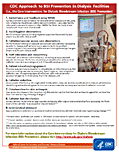Core Interventions
These Core Interventions have been proven to reduce for Dialysis Bloodstream Infections. Apply these interventions when using the Audit Tools and Checklists.
Surveillance and feedback using NHSN
Conduct monthly surveillance for BSIs and other dialysis events using National Healthcare Safety Network(NHSN)—Dialysis Surveillance.. Calculate facility rates and compare to rates in other NHSN facilities. Actively share results with front-line clinical staff. See Data Reports on this website.
Hand hygiene observations
Perform observations of hand hygiene opportunities monthly and share results with clinical staff. See Observation Protocols for Hand Hygiene & Glove Use on this website.
Catheter/vascular access care observations
Perform observations of vascular access care and catheter accessing quarterly. Assess staff adherence to aseptic technique when connecting and disconnecting catheters and during dressing changes. Share results with clinical staff.
Staff education and competency
Train staff on infection control topics, including access care and aseptic technique. Perform competency evaluation for skills such as catheter care and accessing every 6-12 months and upon hire. See Staff Education on this website.
Patient education/engagement
Provide standardized education to all patients on infection prevention topics including vascular access care, hand hygiene, risks related to catheter use, recognizing signs of infection, and instructions for access management when away from the dialysis unit. See Patient Education on this website.
Catheter reduction
Incorporate efforts (e.g., through patient education, vascular access coordinator) to reduce catheters by identifying and addressing barriers to permanent vascular access placement and catheter removal.
Chlorhexidine for skin antisepsis
Use an alcohol-based chlorhexidine (>0.5%) solution as the first line skin antiseptic agent for central line insertion and during dressing changes. Povidone-iodine (preferably with alcohol) or 70% alcohol are alternatives for patients with chlorhexidine intolerance.
Catheter hub disinfection
Scrub catheter hubs with an appropriate antiseptic after cap is removed and before accessing. Perform every time catheter is accessed or disconnected. If closed needleless connector device is used, disinfect connector device per manufacturer’s instructions.
Antimicrobial ointment
Apply antibiotic ointment or povidone-iodine ointment to catheter exit sites during dressing change. See information on selecting an antimicrobial ointment for hemodialysis catheter exit sites (selecting an antimicrobial ointment). Use of chlorhexidine-impregnated sponge dressing might be an alternative.
Selecting an antimicrobial ointment for hemodialysis catheter exit sites
CDC recommends using povidone iodine ointment or bacitracin/gramicidin/polymyxin B ointment at the hemodialysis catheter exit site after catheter insertion and at each hemodialysis session. Bacitracin/gramicidin/polymyxin B ointment is not currently available in the United States. Triple antibiotic ointment (bacitracin/neomycin/polymyxin B) is available and might have a similar benefit but studies have not thoroughly evaluated its effect for prevention of bloodstream and exit-site infections. Other ointments that have been studied include single antibiotic ointments (e.g., mupirocin). However, concerns exist about development of antimicrobial resistance and also their ability to cover the spectrum of potential pathogens (e.g., gram-negative and gram-positive bacteria) that can cause bloodstream infections in dialysis patients.
Another important consideration is that ingredients in antibiotic and povidone-iodine ointments may interact with the chemical composition of certain catheters. Therefore, before any product is applied to the catheter, first check with the catheter manufacturer to ensure that the selected ointment will not interact with the catheter material. See the Catheter Compatibility page for more information.
- Page last reviewed: June 15, 2016
- Page last updated: June 15, 2016
- Content source:


 ShareCompartir
ShareCompartir
